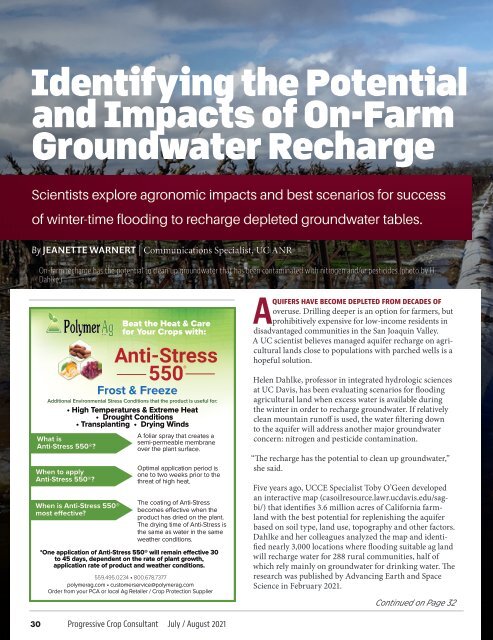PCC June July 2021 e
Create successful ePaper yourself
Turn your PDF publications into a flip-book with our unique Google optimized e-Paper software.
Identifying the Potential<br />
and Impacts of On-Farm<br />
Groundwater Recharge<br />
Scientists explore agronomic impacts and best scenarios for success<br />
of winter-time flooding to recharge depleted groundwater tables.<br />
By JEANETTE WARNERT | Communications Specialist, UC ANR<br />
On-farm recharge has the potential to clean up groundwater that has been contaminated with nitrogen and/or pesticides (photo by H.<br />
Dahlke.)<br />
Additional Environmental Stress Conditions that the product is useful for:<br />
What is<br />
Anti-Stress 550®?<br />
When to apply<br />
Anti-Stress 550®?<br />
Frost & Freeze<br />
• High Temperatures & Extreme Heat<br />
• Drought Conditions<br />
• Transplanting • Drying Winds<br />
When is Anti-Stress 550®<br />
most effective?<br />
Beat the Heat & Care<br />
for Your Crops with:<br />
Anti-Stress<br />
550 ®<br />
A foliar spray that creates a<br />
semi-permeable membrane<br />
over the plant surface.<br />
Optimal application period is<br />
one to two weeks prior to the<br />
threat of high heat.<br />
The coating of Anti-Stress<br />
becomes effective when the<br />
product has dried on the plant.<br />
The drying time of Anti-Stress is<br />
the same as water in the same<br />
weather conditions.<br />
*One application of Anti-Stress 550® will remain effective 30<br />
to 45 days, dependent on the rate of plant growth,<br />
application rate of product and weather conditions.<br />
559.495.0234 • 800.678.7377<br />
polymerag.com • customerservice@polymerag.com<br />
Order from your PCA or local Ag Retailer / Crop Protection Supplier<br />
Aquifers have become depleted from decades of<br />
overuse. Drilling deeper is an option for farmers, but<br />
prohibitively expensive for low-income residents in<br />
disadvantaged communities in the San Joaquin Valley.<br />
A UC scientist believes managed aquifer recharge on agricultural<br />
lands close to populations with parched wells is a<br />
hopeful solution.<br />
Helen Dahlke, professor in integrated hydrologic sciences<br />
at UC Davis, has been evaluating scenarios for flooding<br />
agricultural land when excess water is available during<br />
the winter in order to recharge groundwater. If relatively<br />
clean mountain runoff is used, the water filtering down<br />
to the aquifer will address another major groundwater<br />
concern: nitrogen and pesticide contamination.<br />
“The recharge has the potential to clean up groundwater,”<br />
she said.<br />
Five years ago, UCCE Specialist Toby O’Geen developed<br />
an interactive map (casoilresource.lawr.ucdavis.edu/sagbi/)<br />
that identifies 3.6 million acres of California farmland<br />
with the best potential for replenishing the aquifer<br />
based on soil type, land use, topography and other factors.<br />
Dahlke and her colleagues analyzed the map and identified<br />
nearly 3,000 locations where flooding suitable ag land<br />
will recharge water for 288 rural communities, half of<br />
which rely mainly on groundwater for drinking water. The<br />
research was published by Advancing Earth and Space<br />
Science in February <strong>2021</strong>.<br />
Continued on Page 32<br />
30 Progressive Crop Consultant <strong>July</strong> / August <strong>2021</strong>

















